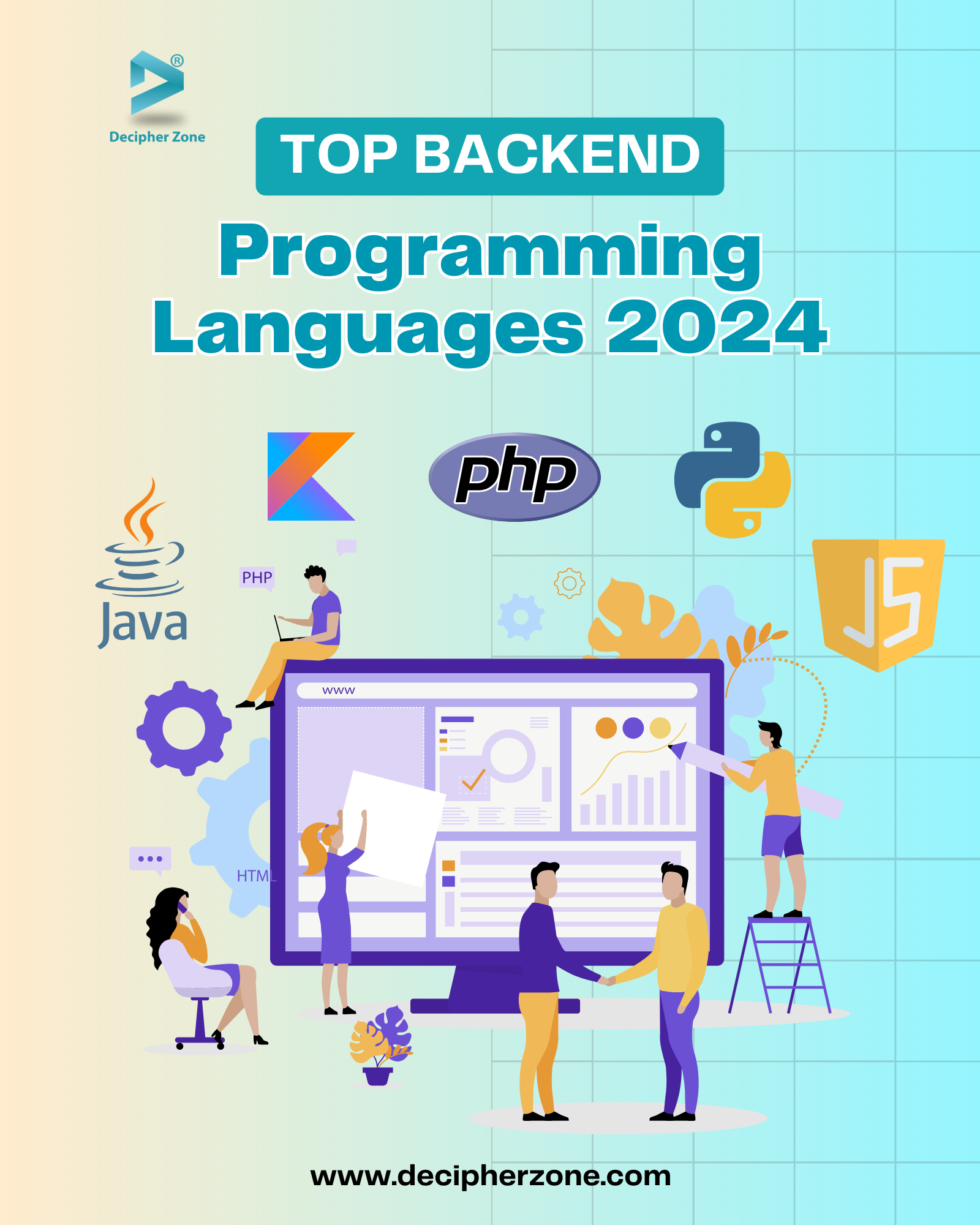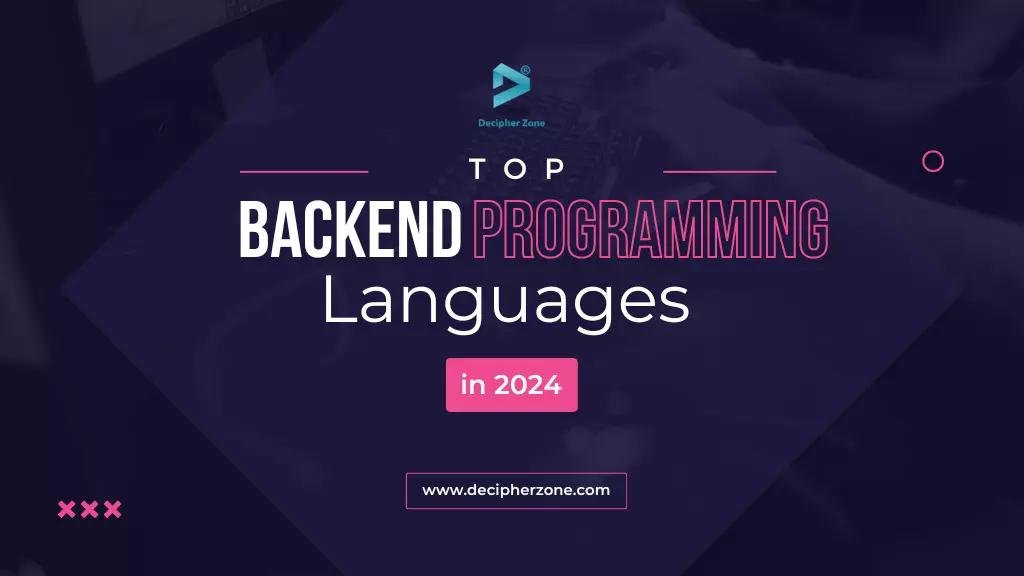We will share the top 5 backend programming languages expected to dominate the industry in 2024 based on experts' predictions and current trends.
Backend programming languages are a crucial part of software development that plays a significant role in determining the overall performance of an application. Backend refers to the side of a software application that users don’t have access to but handles all the parts necessary for the app to work, including back-end logic, APIs, databases, servers, and architectures.
That being said, no application can work without backend programming.
However, with numerous backend programming languages available in the market, choosing the one to learn and opt for in a project can be mind-wrecking, as each has its advantages and disadvantages.
But before diving deeper into the best programming languages for the backend, let’s understand what backend development means.
Read: Top 5 Programming Languages For Desktop App
What is Backend Development?
Backend development involves working on the server side of the application and taking care of everything that ensures it works as expected. Some of the primary responsibilities of a backend developer entail handling APIs, servers, databases, architectures, coding, quality assurance, libraries, scripting, logic, troubleshooting, and debugging.
The backend development team collaborates with project managers, front-end developers, and testers to build code and create the application structure. Their code connects the front-end with the backend and enables communication between the application and the database to store, modify, retrieve, and delete data.
Read: Backend Developer Roadmap
Best Top 5 Programming Languages for Backend Development in 2024
Let's explore the top 5 programming languages for backend development that will be trending in 2024 and beyond, now that we have a better understanding of the backend development process.
-
Java
-
Kotlin
-
Python
-
JavaScript
-
PHP
1. Java
After nearly three decades, Java has remained one of the most favored programming languages among developers. Its continuous version updates, incredibly rich developers' community, and open-source projects have helped it stay relevant with other technologies. Some of the features of Java include automated garbage collection, portability, object-oriented programming, platform independence, encapsulation, multithreading, architectural neutrality, and security.
Java is an easy-to-use programming language that follows the 'write once run anywhere' (WORA) principle, making it highly versatile. It is also relatively easier to write, compile, debug, and learn than traditional programming languages. Java offers reusable code and allows modular program creation, making it highly efficient. Additionally, it has high-performance capabilities that make it a popular choice for developers.
Java can be used to develop server applications, desktop applications, software tools, and system software.
Key Features:
-
Object-Oriented
-
Automated Garbage Collection
-
Multithreaded
-
Platform Independent
-
Easy-to-Use
-
Static Typing
-
Reusable Code
-
Secured
2. Kotlin
Kotlin is a relatively new programming language that first appeared in 2011. It is known for its conciseness, cross-platform compatibility, and fun coding experience. Kotlin is fully interoperable with Java, and its multi-platform feature reduces the need to write and maintain code for different platforms.
This saves time while offering the benefits and flexibility of native programming. Kotlin enjoys growing popularity, support, and contributions from developers worldwide, resulting in a vast range of community libraries.
Read: How To Create Backend APIs Using Spring Boot?
Developers choose Kotlin for various reasons, including its simplicity, asynchronous nature, functional and object-oriented programming capabilities, as well as its interoperability with Java. Although it was initially popular for frontend and Android app development, Kotlin has also gained popularity among backend developers.
Kotlin is best for Android apps and server-side development.
Key Features:
-
Cross-platform compatibility
-
Object-oriented programming
-
Strong community
-
Java interoperability
-
Clear coding
-
Static typing
-
Asynchronous threads
3. Python
Even being one of the oldest programming languages that has been around for almost 33 years, Python gives tough competition to all the new contenders. Its general-purpose, high-level, dynamically typed, multi-paradigm, structured, object-oriented programming makes it another top choice for backend developers.
Python is easy to learn, beginner-friendly, secure, and flexible. It also comes with readable code, extensive library support, third-party modules, community support, user-friendly data structure, compatibility with IoT, and advanced automation capabilities.
Read: Top 10 Programming Languages in 2024
With Python, developers can build task automation solutions, data analysis software, data visualization systems, machine learning systems, etc.
Key Features:
-
Versatility
-
Easy-to-learn
-
Reduces Maintenance Cost
-
Large Community
-
Wide Application
-
Asynchronous coding
-
Security

4. JavaScript
JavaScript, often abbreviated as JS, is the primary language of the web. Initially designed for front-end development, it has gradually gained traction in server-side programming as well. Its popular frameworks such as Node.js, Koa.js, and Express.js, along with its asynchronous nature and robust ecosystem, have contributed to its widespread adoption among backend developers.
What's more, using the same language for both frontend and backend development allows for better collaboration and code sharing among developers. JS can handle multiple requests without blocking the execution threads, resulting in improved scalability and performance.
JavaScript is used to write server-side code to enable seamless connection between the server and client side, leading to dynamic web experiences.
Key Features:
-
Unified Language
-
Large Ecosystem
-
Scalable
-
JSON support
-
Asynchronous
-
Lightweight scripting
-
Dynamic typing
5. PHP
Last on the list, is none other than, PHP which stands for Hypertext PreProcessor. Appeared in 1995, it’s a general-purpose, open-source, multi-paradigm, scripting language suitable for web development. PHP is not only cross-platform compatible but also falls under object-oriented programming. It comes with comprehensive libraries, robust frameworks, just-in-time compilation, and a vast community of developers.
With PHP, programmers can develop customer relationship management systems, backend web development, dynamic web applications, and eCommerce platforms.
Key Features:
-
Secure and scalable
-
Strong server-side capabilities
-
Versatile
-
Easy to use
-
Platform-independent
-
Cost efficient
Conclusion
So far we have explored what backend development involves and the best programming languages for it. While there are no one-fits-all languages, you can choose the ideal one for your project based on its requirements and the advantages that the language offers.
That was all about top backend languages, we hope that the blog has helped you gain insight into which language can be the best for your business. Also, if you are looking for a backend or full-stack development team to build the software application from scratch, contact our experts today, share your project requirements, have a discussion, and get a personalized quote within a few hours.
FAQs: Backend Programming Languages
-
What is backend development?
Backend development refers to the side of a software application that users don’t have access to but handles all the parts necessary for the app to work, including back-end logic, APIs, databases, servers, and architectures.
-
How much does backend development cost?
Backend development costs vary from $5000 to $80,000, based on developer experience, team size, and project timeline.
-
Which backend language to learn in 2024?
Java, Python, PHP, and GoLang are popular backend languages that one can learn to build a robust career in backend development.

